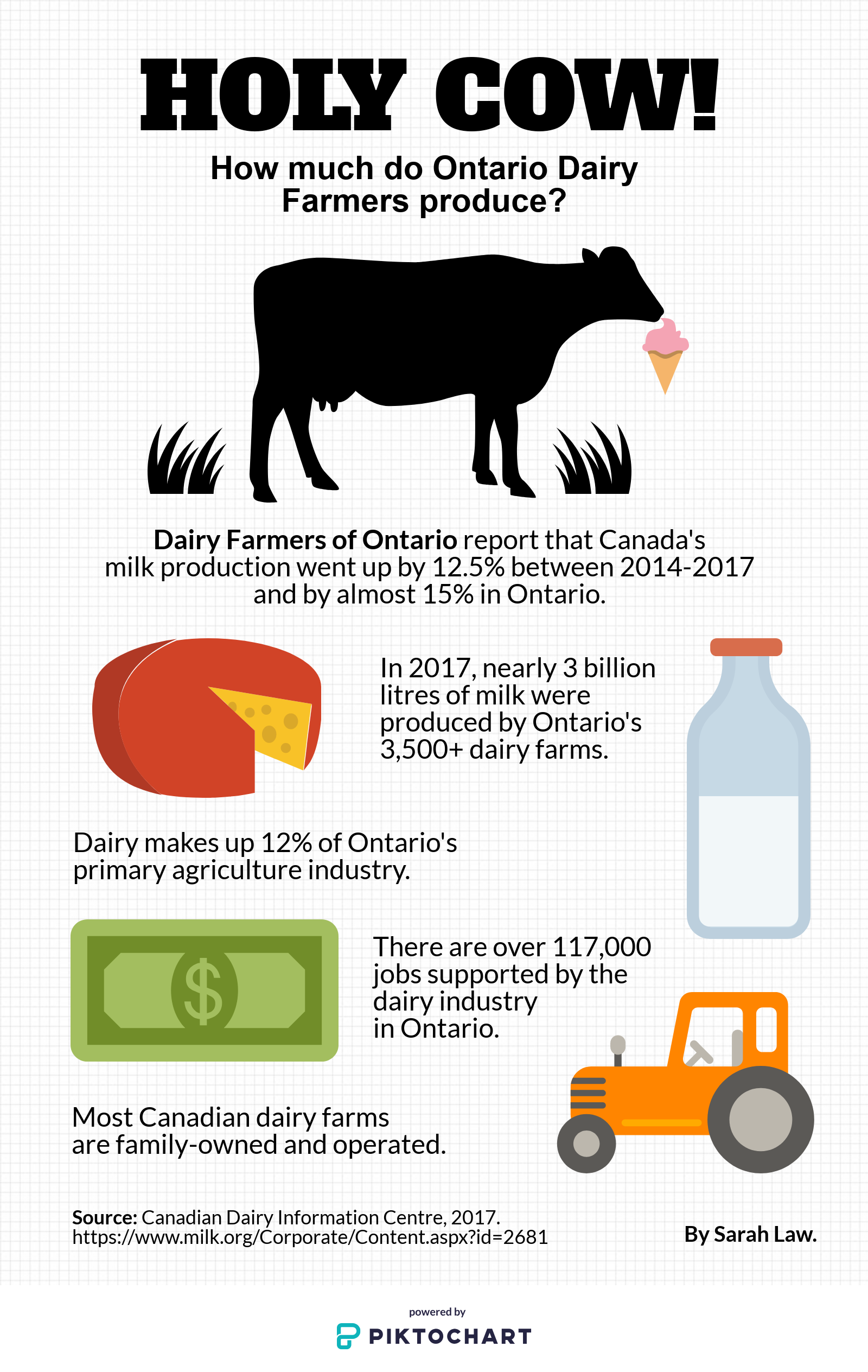Quinte-area dairy farmers worried about changes to Canada’s Food Guide

The production line inside Reid’s Dairy at 222 Bell Blvd. in Belleville. Photo by Syerra Turry, QNet News
By Syerra Turry
BELLEVILLE – Health Canada‘s new food guide is set to be released later this month, seeing its first revamp in over a decade.
One of the biggest changes is a reduction in the number of recommended daily servings of dairy products, and the elimination of dairy as its own category.
That’s worrying dairy farmers across the country.
Canada’s Food Guide is not evidence-based and could lead to long-lasting negative consequences for the dairy sector and Cdn consumers. “It risks harming Canadian consumers by creating confusion about the nutritional value of dairy.” https://t.co/HTkkP0Q2IA
— Dairy Farmers of Ontario (@DairyOntario) January 7, 2019
While there is concern for the well-being of their business, many local farmers say their worries extend beyond self-interest.
Phil Prinzen, of Prinzhaven Farms in Bloomfield, says the recommendation will affect Canadians’ health.
“It’s not a good change, obviously, for dairy farmers, but it’s an even worse change for the health of Canadians,” Prinzen told QNet News this week.
The new guide does not have enough scientific-based research, he said. Madoc Township dairy farmer Amy Beaton agrees.
“It will confuse the consumer about the nutritional value of dairy. They may think that dairy is no longer important to include in your diet. And to me, that’s not science-based,” Beaton said.
Diana Chard, a registered dietitian at Hastings and Prince Edward Public Health, says she agrees with Health Canada that milk products don’t need their own category in the food guide.
As long as you get the required nutrients, specifically Vitamin D and calcium, she said, it doesn’t matter if you get them from dairy products or from alternative sources such as fortified foods, nuts and seeds.
The current food guide, most recently updated in 2007, recommends two servings a day of milk and alternative products for adults aged 19 to 50. For older adults, the recommendation is three servings a day, and for children and teens between the ages on nine and 18, it’s three to four servings a day.
But some local dairy farmers said they don’t expect to see much of a difference in milk consumption after the updated guide is released.
A poll published by the Toronto Star revealed that over 90 per cent of Canadians don’t use the food guide, or don’t trust it.
Hey Health Canada, the Tor Star’s poll w Sunday’s front page story about my @CCforTN founders @barbbradshawMD & @KetoAnaesMD shows of 9865 ppl, 92.56% don’t think CFG is accurate or don’t use it. With the unscientific guiding principles, don’t think the new one will do any better pic.twitter.com/RVENCNHqzq
— Andrew Samis MD PhD (@DrAndrewSamis) January 4, 2019
Bobby Jarrell, owner and operator of RJ Farms of Corbyville, said he doesn’t know of many people who actually follow the food guide.
“If you like cheese, you’re still going to eat cheese. If you like butter, you’re still going to eat butter,” he said.
Mark Donnan, of Donnandale Farms in Stirling-Rawdon, said he too is skeptical about how much influence the food guide has on consumers.
“I’m not sure how much the general public reads the guide. I hope they don’t read it at all,” he said, adding that he doesn’t believe it is science-based.
Prinzen agreed: “Besides the institutions that use it, I don’t know that it will have a direct impact on the dairy industry as much as other deals have that the government has put us through.” The dairy industry suffered a loss with the November 2018 introduction of the United States-Mexico-Canada trade agreement. The deal opened the door to milk products from the U.S. being sold in Canada.
Beaton said the government is not supporting the dairy sector as much as it should.
“The Liberal government is not standing up for the dairy industry” in the new trade deal, she said. And “now they’re doing this by eliminating dairy products from the Canadian food guide. They’re harming us twice.
“We’re being squeezed – we really are.”
The farmers also suggested that if there is a drop in dairy consumption, it could have far-reaching effects on the local economy, because of how many services are needed to operate a dairy farm.
“If consumption drops drastically because of (the food-guide change), it’s going to hurt more than just the dairy farmers,” Donnan said. “There’s all the local economies that they’re evolved around that will be hurt as well.”
Beaton added: “There are quite a few dairy farmers in Hastings and Prince Edward counties, but it’s not only us – it’s the veterinarians, the feed company that brings in feed, the breeding companies. It’s not just farmers that feel the impacts.”
Prinzen called the dairy industry and agriculture in general “the backbone of our region.”
Dairy “is instrumental and probably the biggest gross revenue industry agriculture-wise in the two counties,” he said. “A lot of families do this job as well as support other families by hiring people. The spinoff from a dairy farm is huge. So it’ll affect communities – and if we do feel a pinch, it will trickle down, maybe quicker than we hope.”

 Print This Post
Print This Post






